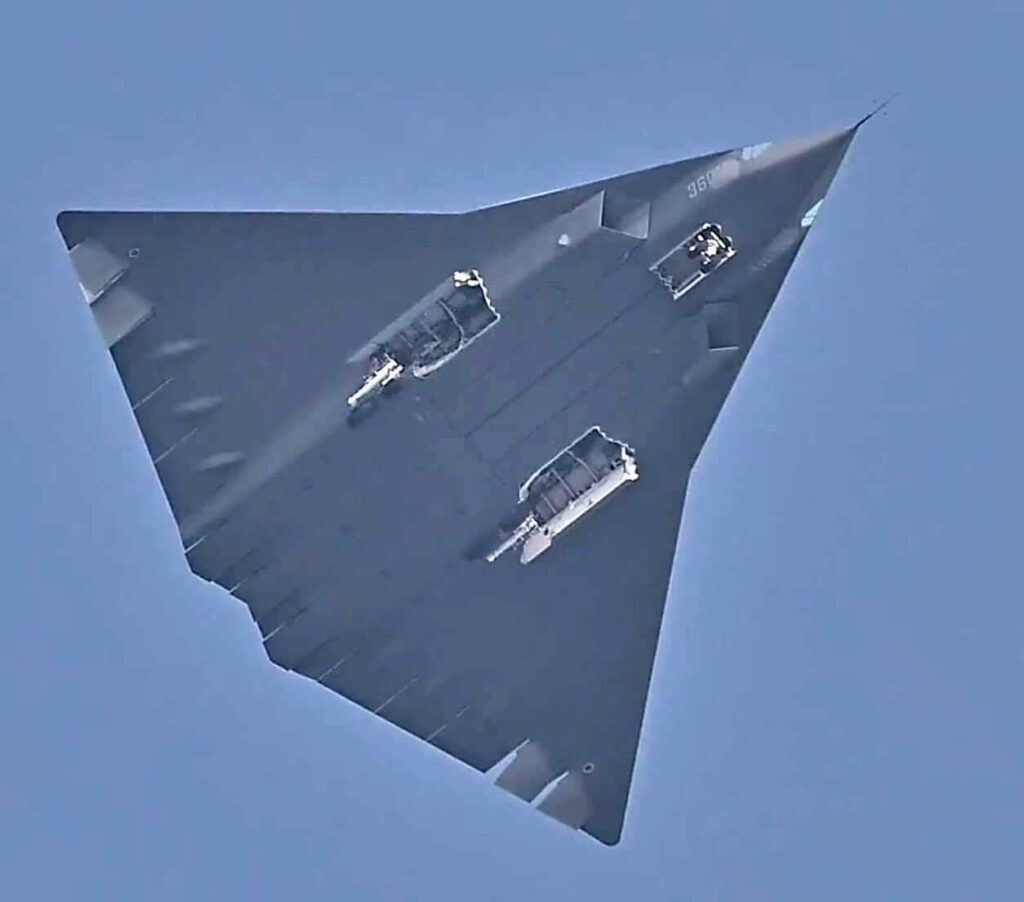The most spectacular debutant, making its maiden flight on December 26 was from Chengdu Aircraft Industry Group: a stealth combat aircraft that various anonymous commenters on the Chinese internet identify as the J-36. It is the largest combat aircraft designed and developed in China, and the second-largest to fly anywhere in 35 years.
The J-36 (if that really is its name) is designed to combine supersonic performance with all-aspect stealth. That’s also the goal of the US Next Generation Air Dominance program, currently stalled by budget and policy issues. (A second article in this series will look at the J-36’s roles.)
There may be more. Anonymous Chinese internet commenters with better records for accuracy than others say that the new arrivals are part of an air warfare ‘tea set’ and that we have not yet seen the ‘teapot’—the long-expected H-20 stealth bomber; this will probably be an analogue to the Northrop Grumman B-21. Nonetheless, the J-36 alone has given observers enough to chew on.
Its revelation followed the pattern as the appearance of the J-20 fighter exactly 14 years earlier. No technical details have been released officially, and it’s unlikely that any will be soon, but a prototype for the design flew in daylight from an airfield in a dense urban area, and the Chinese government permitted images to be released.
The aircraft was chased by a two-seat J-20B, giving a good indication of its size. It’s longer than the J-20—about 23 metres—and its double-delta wing spans an estimated 19 metres, with around 200 square metres of wing area. (The F-22’s wing area is 78 square metres.) As I commented on the Global Combat Aircraft Program’s Tempest design, large, moderately swept deltas can accommodate a lot of fuel and are very useful if the designer is looking for long range.
The tandem-wheel main landing gear units point to a big aircraft, since single wheel, tyre and brake units are inadequate at weights above about 35 tonnes. The main weapon bay, about 7.6 metres long, and supplementary side bays for smaller weapons also suggest considerable size. A 55-tonne take-off weight is a reasonable guess, two-thirds more than the J-20 and compared with an estimated 82 tonnes for the Northrop Grumman B-21.
The J-36 planform unequivocally speaks of stealth and supersonic speed. It is a modified version of the Hopeless Diamond, the first shot by Lockheed’s Skunk Works at all-aspect stealth, which got that name because it could not be made to fly with 1970s technology. Another variation on the planform was tried in 2003 with Northrop Grumman’s X-47A Pegasus unmanned combat aircraft demonstrator, which did fly. Once.
On the J-36, the diamond is stretched into a double-delta to reduce transonic and supersonic drag. It has a leading-edge kink, a change in sweep angle. That’s not ideal from the standpoint of radar cross-section but, as Northrop Grumman’s cranked-arrow designs have shown, it can be lived with. There is an unbroken edge and chine line around the aircraft, and all sensor apertures are inside it (not the case with the J-20 and other fighters). That is the foundation of all-aspect stealth.
There are no vertical tail surfaces and no visible control surfaces other than the wing trailing edges, with five moving panels on each side and one behind each engine; such surfaces are called ‘elevons’. (It’s possible that there are flight-control effectors that we have not yet seen, such as inlaid panels in the upper surface of the wing.) The hinge lines of trailing-edge surfaces appear to be covered by flexible skins. The outer pair of surfaces are split horizontally to form brake-rudders, as on the B-2 and B-21, and were fully open in all pictures of the first flight.
Elevons have reliably provided pitch and roll control since the 1950s, but dispensing with the vertical tail is a challenge, and more so with a supersonic aircraft. The J-36 can rely on its brake-rudders when it is not close to an enemy. But, for stealth in a threat zone, it will need to keep them closed and use both aerodynamic and propulsive effects to keep the pointy end in front—which brings us to another almost unique feature.
J-36 has three engines, side-by-side at the rear of the broad centre-body. F-22-like inlets of caret shape, with swept and canted lips, under the wing leading edge, supply the left and right engines, and the center engine is fed by a diverterless supersonic inlet above the body.
The three engine exhausts are ahead of and above the trailing edge, which comprises what appear to be articulating panels. Full turbofan reheat boost would impose scary thermal and acoustic loads on the trailing edge structure. (The trenches at the rear of the Northrop YF-23 into which its engines exhausted did not endure the environment as well as expected.) This tends to support the idea that the J-36’s engines are either non-afterburning or have limited afterburning used for transonic acceleration.
Some commentators have suggested that the J-36 has three engines because China does not have an engine design large enough to power it in a twin installation. This doesn’t seem likely. Even if your available engines were delivering only two-thirds of the thrust required for a production-size twin-engine aeroplane, you could build an 80 percent linear-scale demonstrator with two-thirds the wetted area, and it would be both easier to develop and more representative of the final configuration.
There has to be a good reason to justify the added complexity. One possibility is that the two outer engines provide enough thrust for subsonic flight, while operating at full thrust and peak efficiency, and the third cuts in for supersonic cruise.
A variation on this theme would be to have a center engine optimized for supersonic flight, which would deliver some of the advantages of a variable-cycle engine without its complexity and risk (I can hear the logisticians screaming, 12,000km away) but in a configuration that could be fitted later with a VCE.
One former combat aircraft designer suggests that the trijet arrangement could be influenced by stability and control considerations, allowing for symmetrical thrust vectoring in pitch with one engine inoperative.
The trailing edge flaps would provide thrust vectoring in pitch when used symmetrically and in roll with the outer engines’ exhaust deflected asymmetrically (while still using the center engine for pitch). It is entirely possible that fluidic control (injecting fan-stream air asymmetrically into the nozzle) could be used in the yaw axis.
Three engines in the thrust class of 22,000 lb (10,000kg or 100-kilonewtons) should be enough to make the J-36 a supercruiser—an aircraft that can fly supersonically without using fuel-guzzling afterburning. Its sweep angles point to doing this at Mach 1.8 to Mach 2.0 (1900km/h to 2200km/h, depending on altitude). The key is not so much achieving enough static thrust but building the engine to withstand the high temperatures at the exit of its compressor. China’s engine technology has been headed in this direction.
Agility? High maneuverability is in opposition to combining supersonic cruise and range—the F-22 being deficient in the latter—because it demands large control forces and high installed thrust (and the weight it brings). Physics are a limitation: the J-36’s trailing-edge controls and thrust-vectoring systems must provide all the control force for the aircraft, unassisted by vertical stabilizers, canards or pitch-recovery devices like the Sukhoi Su-57’s movable leading-edge root extensions.
As for the need for maneuverability by a supersonic stealth aircraft packing a heavy weapon load and long-range sensors, the reader is referred to the classic movie short, Bambi Meets Godzilla.
We will learn more about the J-36 as it follows the pattern of the J-20 through a pre-production and service test phase. There are other puzzles about the design: apparently large electro-optical sensor windows on either side of the nose, and a dark-tinted canopy that wouldn’t be road-legal in many US states. But one thing can be said firmly: those who accuse Chengdu chief engineer Yang Wei and other Chinese designers of being copyists need to take a seat.

